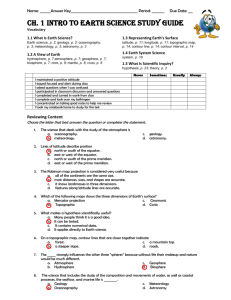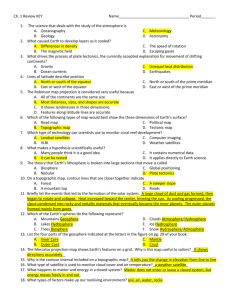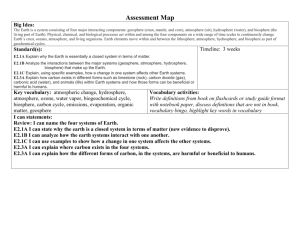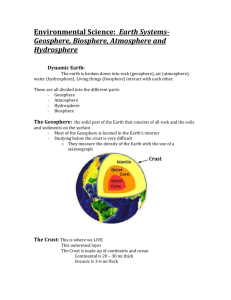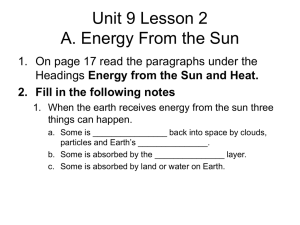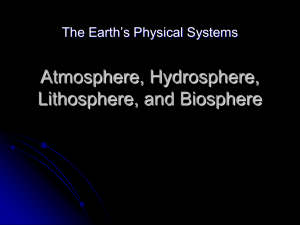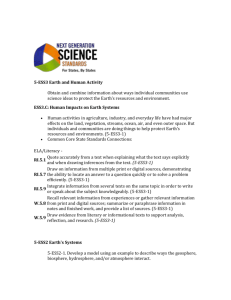Unit 1 Pretest and Introduction Assignment
advertisement
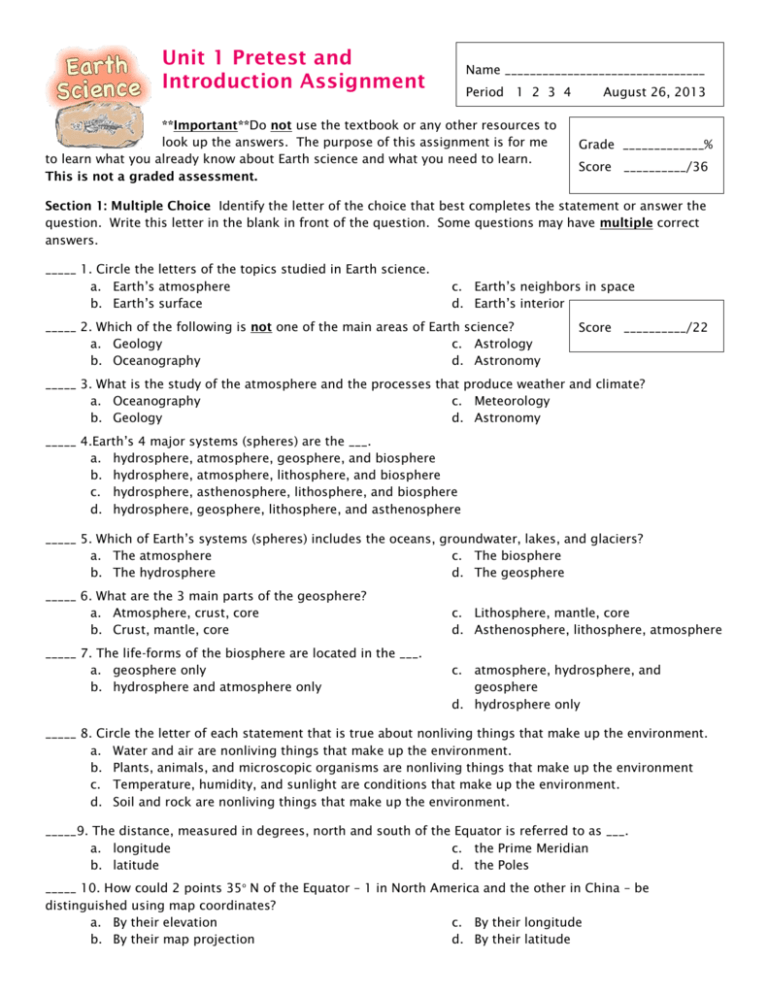
Unit 1 Pretest and Introduction Assignment Name ________________________________ Period 1 2 3 4 **Important**Do not use the textbook or any other resources to look up the answers. The purpose of this assignment is for me to learn what you already know about Earth science and what you need to learn. This is not a graded assessment. August 26, 2013 Grade _____________% Score __________/36 Section 1: Multiple Choice Identify the letter of the choice that best completes the statement or answer the question. Write this letter in the blank in front of the question. Some questions may have multiple correct answers. _____ 1. Circle the letters of the topics studied in Earth science. a. Earth’s atmosphere b. Earth’s surface c. Earth’s neighbors in space d. Earth’s interior _____ 2. Which of the following is not one of the main areas of Earth science? a. Geology c. Astrology b. Oceanography d. Astronomy Score __________/22 _____ 3. What is the study of the atmosphere and the processes that produce weather and climate? a. Oceanography c. Meteorology b. Geology d. Astronomy _____ 4.Earth’s 4 major systems (spheres) are the ___. a. hydrosphere, atmosphere, geosphere, and biosphere b. hydrosphere, atmosphere, lithosphere, and biosphere c. hydrosphere, asthenosphere, lithosphere, and biosphere d. hydrosphere, geosphere, lithosphere, and asthenosphere _____ 5. Which of Earth’s systems (spheres) includes the oceans, groundwater, lakes, and glaciers? a. The atmosphere c. The biosphere b. The hydrosphere d. The geosphere _____ 6. What are the 3 main parts of the geosphere? a. Atmosphere, crust, core b. Crust, mantle, core _____ 7. The life-forms of the biosphere are located in the ___. a. geosphere only b. hydrosphere and atmosphere only c. Lithosphere, mantle, core d. Asthenosphere, lithosphere, atmosphere c. atmosphere, hydrosphere, and geosphere d. hydrosphere only _____ 8. Circle the letter of each statement that is true about nonliving things that make up the environment. a. Water and air are nonliving things that make up the environment. b. Plants, animals, and microscopic organisms are nonliving things that make up the environment c. Temperature, humidity, and sunlight are conditions that make up the environment. d. Soil and rock are nonliving things that make up the environment. _____9. The distance, measured in degrees, north and south of the Equator is referred to as ___. a. longitude c. the Prime Meridian b. latitude d. the Poles _____ 10. How could 2 points 35o N of the Equator – 1 in North America and the other in China – be distinguished using map coordinates? a. By their elevation c. By their longitude b. By their map projection d. By their latitude _____ 11. On the global grid, the Prime Meridian is at ___. a. 0o latitude b. 90o latitude c. 0o longitude d. 90o longitude _____ 12. On a topographic map, contour lines that form a circle indicate a(n) ___. a. lake b. ocean c. hill _____ 13. Differences in elevation are best shown using a ___. a. Mercator projection map b. gnomonic projection map d. depression c. Robinson projection map d. topographic map _____ 14.Any size group of interacting parts that form a complex whole is a(n) ___. a. system (sphere) c. tectonic plate b. energy source d. Earth’s core _____ 15. Earth is considered a system because all of it parts ___. a. represent separate closed systems c. were formed at the same time b. interact d. are powered by the same energy source _____ 16. What are the 2 sources of energy for the Earth system? a. Lightning and the Sun b. The Sun and Earth’s interior c. The Sun and wind d. Earth’s interior and the winds _____ 17. The Sun’s energy drives which of the following processes? a. Volcanic eruptions c. Weather and ocean circulation b. Earthquakes d. Mountain building _____ 18. Which of the following is powered by energy from Earth’s interior? a. Erosion c. Weather b. A volcano d. Ocean circulation _____ 19. Which of the following is an environmental hazard created by humans? a. Air pollution c. Hurricane b. Flood d. Earthquake _____20. A a. b. c. d. scientific hypothesis can become a theory if ___. the entire scientific community accepts it the hypothesis is tested extensively and competing hypotheses are eliminated there are no other competing hypotheses the hypothesis can be tested at least once _____ 21. A preliminary untested explanation that tries to explain how or why things happen in the manner observed is a scientific ___. a. law b. theory c. fact d. hypothesis _____ 22. A scientific idea that is well tested and widely accepted by the scientific community is called a(n) ___. a. hypothesis b. inquiry c. theory d. method Section 2: Matching Match each term to its description. Write this letter in the blank in front of the question. Term Description _____ 1. Hydrosphere a. all life-forms on Earth _____ 2. Atmosphere b. composed of the core, mantle, and crust _____ 3. Geosphere c. dense, heavy inner sphere of Earth _____ 4. Biosphere d. thin outside layer of Earth Surface _____ 5. Core e. the water portion of Earth _____ 6. Mantle f. the gaseous envelope around Earth _____ 7. Crust g. located between the crust and core of Earth Score __________/14 - - - - - - - - - - - - - - - - - - - - - - - - - - - - - - -- - - - - - - - - - - - - - - - - - - - - - - - - _____ 1. Longitude a. the distance north or south of the Equator _____ 2. Globe b. the distance east or west of the Prime Meridian _____ 3. Eastern, Western c. the line of latitude around the middle of the globe at 0o _____ 4. Prime Meridian d. the line of longitude at 0o _____ 5. Northern, Southern e. the 2 hemispheres formed by the Equator _____ 6. Latitude f. the 2 hemispheres formed by the Prime Meridian and the 180o meridian _____ 7. Equator g. a spherical model of Earth
